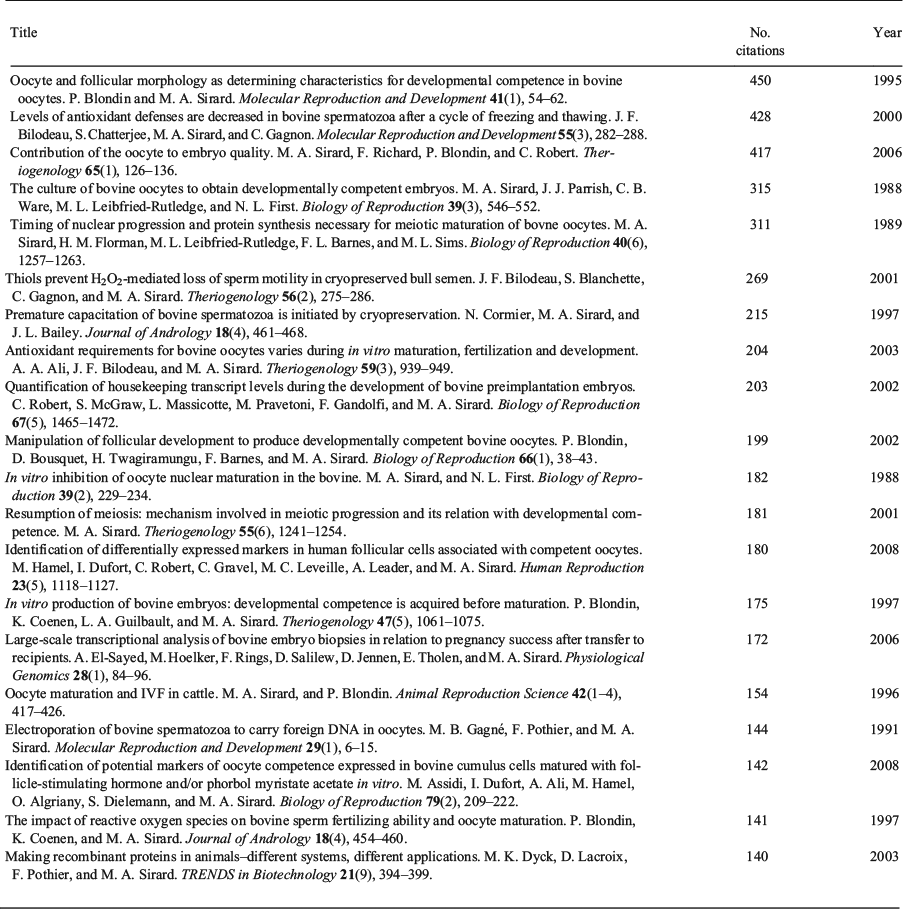Recipient of the 2018 IETS Pioneer Award: Dr Marc-André Sirard
Reproduction, Fertility and Development 30(1) xix-xxi https://doi.org/10.1071/RDv30n1_PA
Published: 4 December 2017
Dr Marc-André Sirard graduated in 1981 with a DVM from Université de Montréal, Canada. He went on to obtain his PhD in 1985 in reproductive physiology with Dr Raymond Lambert of Université Laval, Quebec, Canada. It was during his PhD that Dr Sirard used laparascopic technology to recover bovine oocytes to produce Canada’s first six IVF calves. He then pursued postdoctoral studies with Dr Neil First of University of Wisconsin, USA, where he began his quest to understand how oocytes acquire developmental competence. In 1987, he came back to Université Laval as an assistant professor, where he attained the NSERC-SEMEX Industrial Chair 3 years later, which led to his promotion to full professorship in the Department of Animal Science in 1995. Dr Sirard has been very engaged in his field. In 1996, he was a member of the IETS Board of Governors and organised the 1999 IETS meeting in Quebec City, Canada. It was also in 1996 that he founded the Centre de Recherche en Biologie de la Reproduction, a renowned centre that regrouped top Canadian scientists in reproductive biology and known by many in the field. In 2000, Dr Sirard obtained the first Canadian Research chair in the field of animal reproduction and genomics, which was renewed in 2007 and 2014 for two consecutive 7-year terms. This chair was instrumental in the development of the genomic platform now in place at Laval. In 2001, he also found the time to become the VP Research for TGN Biotech based in Quebec, Canada, a start-up biotechnology company with Laval University. In 2006, he became Associate VP of research with Laval University (2006–2007). He was also the co-founder of a national research network in domestic animal embryo genomic (EmbryoGENE) in 2008. This network encompasses 28 scientists across Canada and 12 collaborators worldwide. The financial support for the network was CA$8 million for 5 years including some CA$3 million from the animal reproduction industries. This permitted the development of a user-friendly transcriptomic platform to obtain valuable data from samples as small as a blastocyst. This resulted in international collaborations with his peers resulting in more than 40 different types of blastocysts (conditions of culture) having now been characterised with this unique platform. The building of the cow folliculome is continuing to progress and several EmbryoGENE users already have access to an integrated website where each gene can be viewed in tens of different conditions.

|
Dr Sirard is renowned as one of the pioneers who developed bovine in vitro maturation and in vitro fertilisation in the mid-80s. In fact, he was among the first to have used laparascopy in the cow to retrieve bovine oocytes and after IVM, IVF and culture in rabbit oviducts, produce live progeny with this innovative assisted reproductive technology. Furthermore, Dr Sirard has developed a unique approach to optimise follicular quality, which resulted in the publication of the best procedure to harvest oocytes for commercial IVF. This work, in collaboration with the industry, has a growing impact on practices worldwide and significantly changed the success rates of animal genetic propagation in adults as well as in prepubertal animals. Dr Sirard has developed new knowledge in superovulation and oocyte developmental competence that has served as a technological platform to enhance the efficiency of animal reproduction. In fact, Dr Sirard developed superovulation coasting protocols for IVM in cows (2002–2012), which has significantly enhanced IVF success, particularly in dairy cows. This technique has more than doubled the regular success rates and provided better embryos, better pregnancies and better calves than regular IVM from non-stimulated animals. Later in his career, Dr Sirard obtained a Canadian Research Chair in genomics, and has since developed a unique set of tools to study gametes, embryos and follicular tissues in bovine and porcine species. These tools are different from what is available elsewhere as they have been tailored for domestic animal research using small samples as oocytes and embryos. They also include a bioinformatics pipeline, allowing scientists and graduate students worldwide to analyse their results online (http://emb-bioinfo.fsaa.ulaval.ca/).
Dr Sirard has continued to push both fundamental and commercial scientists to question our understanding of reproductive biology, as well as developing novel experimental methodologies, such as development of adequate maturation conditions for cow oocytes in vitro (1986–1990), use of meiotic inhibition conditions to maintain developmental competence in cow oocytes (1990–1995), understanding follicular atresia phenomena in relation to oocyte developmental competence in cows (1995–2000), and discovery of specific oocyte and ovarian genes in relation to developmental competence in cows and humans (2000–2005). Examples of novel biotechnologies developed by Dr Sirard are laparoscopy (1984), IVF calves (1985), IVM in cows (1986), superovulation protocols with coasting (1999) and the first embryo cDNA slide for the bovine (Blue Chip). Dr Sirard has characterised the process of early follicular atresia in relation to the generation of developmentally competent oocytes for IVF, as well as unravelling important genes involved in follicular maturation and oocyte competence. With more than 24 invited lectures since 2009 (most at animal reproduction meetings), 245 peer-reviewed publications in international reproductive journals (70 since 2008) and 6 book chapters, Dr Sirard has successfully and clearly communicated his research results to the scientific and industrial communities in the area of reproductive technology for assisted reproduction. In fact, he has given over 70 invited talks in his career, 24 of these in the last 6 years. Since the beginning of his career, his papers have been cited over 13 000 times.
Dr Sirard has repeatedly assembled the brightest minds in reproductive biology and supported team research endeavours. In 1995, he created the Centre de Recherche en Biologie de la Reproduction (CRBR), a very active team of researchers interested in animal reproduction, development of advanced technology, responsible use of assisted reproductive technologies, and ethical issues related to the field. The complementary skills of the CRBR researchers allow them to work jointly towards improving reproductive performance in domestic mammals. By furthering scientific knowledge and contributing to the advancement of technology, the CRBR aims to facilitate the training of high-level scientists in the field. This group is now internationally recognised, has a membership of 16 regular scientists and 8 associated scientists for a global annual research budget of CA$5 million. Another example of Dr Sirard’s leadership is the creation of EmbryoGENE, a concerted pan-Canadian effort devoted to understanding the genome and epigenome of the competent bovine and porcine embryo. It aims to determine how various treatments relating to maternal nutrition, the environment of the embryo, and the application of assisted reproductive technologies influence developmental competence of the early embryo and, as a consequence, the future health of offspring derived from such embryos. More than 25 collaborations have been initiated and half of those are outside Canada. Between 2002 and 2013, four embryogenomic meetings were organised (two in Europe and two in North America). These specialised workshop meetings were organised to discuss and define the standards of practice in domestic animal genomics for all members of the international community.
Recognised by scientific peers in reproductive biology, Dr Sirard has devoted much of his time and effort to support various scientific societies, as well as participate in scholarly activities, such as symposia, and service to society. Some examples of these are: board member of IETS (1996–1997), board member of ACFAS (Association francophone pour le savoir, 6000 members) (2000–2004) and President of ACFAS (2003–2004), and board meetings of SSR (2004–2005). An influential leader in the field of reproductive biology, Dr Sirard has led many ethical debates and forums on various aspects relating to animal reproduction. Dr Sirard participated as member of editorial boards of the most influential journals in our field, such as Reproduction, Molecular Human Reproduction, Reproduction Fertility and Development and Molecular Reproduction and Development. Dr Sirard has organised several international meetings over the last 14 years. His first major meeting was IETS in 1999 followed by SSR in 2005. In addition, he organised four specialised embryogenomic meetings in the USA and Europe. Dr Sirard has trained many highly qualified personnel including 40 master students, 32 PhD and 15 post doc, as well as co-directing 20 other students. This is a true indication of the trust of his colleagues towards his mentorship. Such numbers are truly remarkable and many of his trainees have become successful scientists today. Below you will find some of Dr Sirard’s most cited material that he published in his career.

|
References
Dufort, I., Robert, C., and SIRARD, M. A. (2014). Studying bovine early embryo transcriptome by microarray. In ‘Nuclear Reprogramming. Methods in Molecular Biology (Methods and Protocols), vol. 1222.’ (Eds A. Jouneau, H. Jammes, N. Beaujean.) pp. 1–16. (Humana Press: New York.)SIRARD, M. A., and Gilbert, I. (2013). Omics as tools for oocyte selection. In ‘Biology and Pathology of the Oocyte’. (Ed. A. Trounson.) pp. 297–305. (Cambridge University Press: Cambridge.)
SIRARD, M. A. (2013). Screening for oocyte competence. In ‘Oocyte Physiology and Development in Domestic Animals’. (Ed. R. Krisher.) pp. 184–198. (Wiley-Blackwell: Oxford.)
Assidi, M., and SIRARD, M. A. (2012). Cumulus cell gene expression as a marker of oocyte quality. In ‘Oogenesis’. (Eds G. Coticchio, D. Albertini, L. De Santis.) pp. 231–252. (Springer-Verlag : London.)
SIRARD, M. A. (2011). Mammalian embryonic genome activation. In ‘Reproduction in Domestic Ruminants VII’. (Eds M. C. Lucy, J. L. Pate, T E. Spencer.). pp. 212–225. (Nottingham University Press: Nottingham.)
SIRARD, M. A. (2011). Genomic regulation through RNA in oocyte maturation of large mammals. In ‘Oocyte Maturation and Fertilization: A Long History for a Short Event’. (Eds E. Tosti and R. Boni.) pp. 71–79. (Bentham Science Publishers Ltd.)


